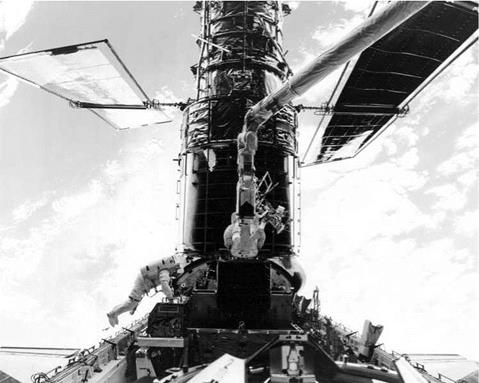STS-103
|
Int. Designation |
1999-069A |
|
Launched |
19 December 1999 |
|
Launch Site |
Pad 39B, Kennedy Space Center, Florida |
|
Landed |
27 December 1999 |
|
Landing Site |
Runway 33, Shuttle Landing Facility, KSC, Florida |
|
Launch Vehicle |
OV-103 Discovery/ET – 101/SRB BI-099/SSME #1 2053; |
|
#2 2043; #3 2049 |
|
|
Duration |
7 days 23 hrs 10 min 47 sec |
|
Call sign |
Discovery |
|
Objective |
3rd Hubble Servicing Mission (HST-SM 3A) |
Flight Crew
BROWN Jr., Curtis Lee, 43, USAF, commander, 6th mission
Previous missions: STS-47 (1992); STS-66 (1994); STS-77 (1996); STS-85 (1997);
STS-95 (1998)
KELLY, Scott Joseph, 35, USN, pilot
SMITH, Steven Lee, 40, civilian, mission specialist 1, 3rd mission Previous missions: STS-68 (1994); STS-82 (1997)
CLERVOY, Jean-Francois Andre, 41, civilian, ESA mission specialist 2,
3rd mission
Previous missions: STS-66 (1994); STS-84 (1997)
GRUNSFELD, John Mace, 41, civilian, mission specialist 3, 3rd mission Previous missions: STS-67 (1995); STS-81 (1997)
FOALE, Colin Michael, 42, civilian, mission specialist 4, 5th mission Previous missions: STS-45 (1992); STS-56 (1993); STS-63 (1995); STS-84/86 (1997)
NICOLLIER, Claude, 55, civilian, ESA mission specialist 5, 4th mission Previous missions: STS-46 (1992); STS-61 (1993); STS-75 (1996)
Flight Log
This mission faced nine scrubs or delays due to mechanical issues or the weather, before finally reaching orbit. The mission had been scheduled for June 2000, but when the third of six gyroscopes on Hubble had failed, the service mission was divided into two separate Shuttle missions and the first was advanced. STS-103 was now due to fly in October 1999 and the second mission would follow in 2001. In mid-August, Shuttle management decided to inspect the wiring of the Shuttle fleet after the incidents during the STS-93 launch in July. As a result, STS-103 had a new launch date of 23 October, but the amount of work required to complete the repairs saw the launch put back further to 19 November. This gave NASA the option of launching either STS-103 or
|
Astronauts Mike Foale (left) and Claude Nicollier (in the RMS) install a Fine Guidance Sensor into a protective enclosure in the payload bay during the second EVA |
the Space Radar Topography Mission (STS-99) first. On 13 November, Hubble was placed in safe mode when a fourth gyroscope failed. It was left pointing its arrays constantly at the Sun to generate electrical power, pending the service mission.
During the first weeks of December, seven new launch dates were set before the vehicle finally left the pad. The causes for the delays varied from the discovery of a 1.5-cm-long drill bit lodged in main engine #3 (the engine was replaced on the pad), to additional wiring damage in an umbilical between the Orbiter and ET, to the Thanksgiving holiday. There were also repairs to a dented LH main propulsion line, the inspection and verification of a number of welds in pressure lines, and problems with the weather. With the launch planned for 19 December, mission managers had decided to restrict the mission duration to eight days instead of the planned ten, to ensure that all flight and ground systems were secured for transition to year 2000. Shuttle computers are unable to operate over the change of year, and with the change to year 2000 expected to highlight additional glitches, NASA wanted to ensure it did not have a vehicle flying or linked to active ground systems at this time.
The first few days in the orbiter consisted of adjustments to the orbit and preparations for the work ahead. It took 30 orbits to reach the Hubble, which was captured by RMS on 21 December. Three EVAs were completed by the crew. Steve Smith (EV1) and John Grunsfeld (EV2) completed the first and third excursions, while Mike Foale (EV3) and ESA Astronaut Claude Nicollier (EV4) performed the mission’s second EVA. During EVA 1 (22 Dec, 8 hours 16 minutes), the astronauts replaced the three Rate Sensor Units which each contained two of the gyroscopes, and installed six cell-phone-sized Voltage/Temperature Improvement Kits between the telescope’s six ten-year-old batteries and its solar arrays. These would prevent overheating and overcharging of the batteries. EVA 2 (23 Dec, 8 hours 10 minutes) saw the astronauts install a new computer in the telescope which was 20 times faster than its older unit. They also installed a new fine-guidance sensor. The final EVA (24 Dec, 8 hours 8 minutes) included the installation of a transmitter to send scientific information from the telescope to the ground, replacing the one that had failed the year before. This was a delicate operation, as the transmitter was not part of the telescope and was not designed to be replaced by the astronauts. However, using specially designed tools, they achieved the task, demonstrating the value of utilising humans to effect repairs and servicing on units that otherwise could not be replaced or repaired. The final EVA also saw the installation of a solid state digital recorder, to replace one of the older mechanical reel-to-reel recorders.
Hubble was released back into orbit on Christmas Day 1999. This was only the third time that an American crew had been in space at Christmas aboard an American spacecraft. The first was the historic Apollo 8 mission around the Moon in 1968 and the second was during the third and final Skylab (SL-4) mission in 1973. In addition, astronauts John Blaha and Dave Wolf had spent Christmas and New Year aboard Mir with Russian colleagues in 1996 and 1997 respectively.
Milestones
214th manned space flight
126th US manned space flight
6th Shuttle mission
27th flight of Discovery
42nd US and 74th flight with EVA operations
3rd HST service mission
1st ESA astronaut to perform EVA from Shuttle (Nicollier)











